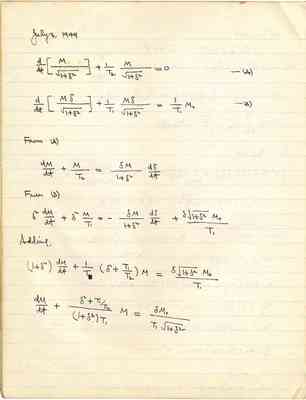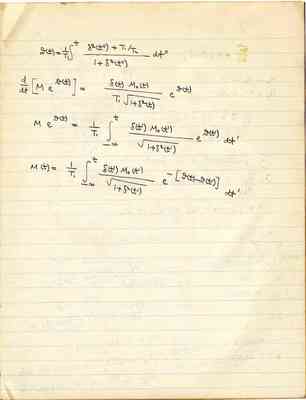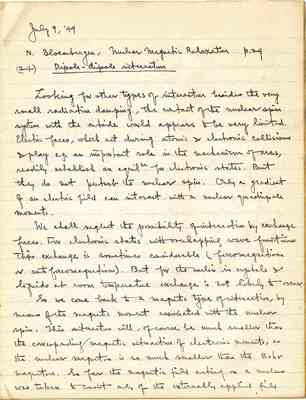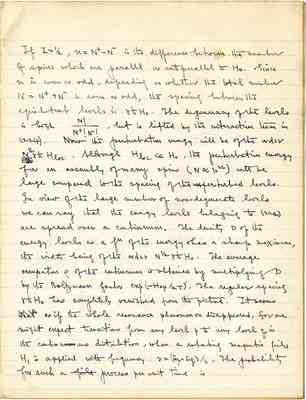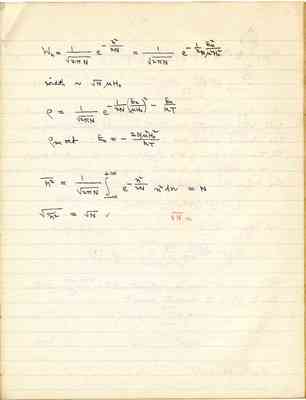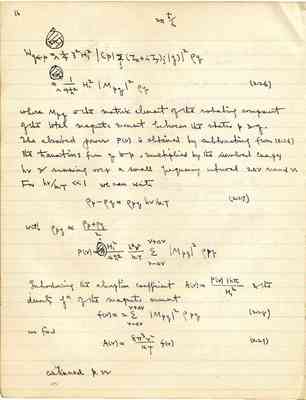Pages That Need Review
Research Notes II, 1949
11
July 9, '49
N. Bloembergen, Nuclear Magnetic Relaxation p. 29 (2.4) Dipole-dipole interaction
Looking for other types of interaction besides the very small radiation damping, the contact of the nuclear spin system with the outside world appears to be very limited. Electric forces, which act during atomic & electronic collisions & play e.g. an important role in the mechanism of arcs, readily establish an equilibrium for electronic states. But they do not perturb the nuclear spin. Only a gradient of an electric field can interact with a nuclear quadripole moments.
We shall neglect the possibility of interaction by exchange forces. For electronic states with overlapping wave functions this exchange is sometimes considerable (ferromagnetism or anti ferromagnetism). But for the nuclei in crystals & liquids at room temperature exchange is not likely to occur.
So we come back to a magnetic type of interaction, by means of the magnetic moment associated with the nuclear spin. This interaction will, of course, be much smaller than the corresponding magnetic interaction of electronic moments, as the nuclear magneton is so much smaller than the Bohr magneton. So for the magnetic field acting on a nucleus was taken to consist only of the externally applied field
12
H₀+H₁ and the thermal radiation field. Every nucleus, however, also experiences the field produced by the magnetic moments of its neighbors. If this dipole-dipole interaction is taken into account, the Hamiltonian [f-an] assembly of spins becomes
The sum over j in the right hand term represents the internal or local field at the ith nucleus; is the radius vector connecting the ith & the jth spin. The problem connected with (2.24) is [she?] of an extreme complexity. It is the equation of motion for N particles, where N is of the order of Avogadro number. The local field will, at any time, be of the order of few [aersted?]. It is mainly determined by the nearest neighbors, since the magnitude of a dipole field decreases as the inverse cube of the distance: where a is the internuclear distance. For two protons, me Å apart, we find Hloc ≈ [lo ousted?].
The energy levels of the unputurbed system, without dipole-diple interaction are
13
If I=1/2, is the difference between the number of spins which are parallel or antiparallel to H₀. Since n is even or odd, depending on whether the total number is even or odd, the spacing between the equidistant levels is γħH₀. The degeneracy of the level in high , but is lifted by the interaction [term?] in (2.24). Now the perturbation energy will be of the N order . Although , the perturbation energy for an assembly of many spins (N ≈ [10?]²²) will be large compared with spacing of the unperturbed levels. In view of the large number of non-degenerate levels we can say that the energy levels belonging to (2.24) are spread over a continuum. The density D of the energy levels as a fn of the energy has a sharp maximum, the width being of the order N1/2γħH₀. The average occupation ρ of the coninuum is obtained by multiplying by the Boltzmann factor exp(-H0pkT). The regular spacing γħH₀ has completely vanished from the picture. It seems that as if the whole resonance phenomenon disappeared, for we might expect transitions from any level p to to any level q in the continuous distribution, when a rotating magnetic field H₁ is applied with frequency ν = ([Ep - Eq?])/h. The probability for such a field process per unit time is
16
where Mpg in the matrix element of the rotating component of the total magnetic moment between the states p & q. The absorbed power P(ν) is obtained by subtracting from (2.26) the transitions from q to p, multiplied by the involved energy hν & running over a small frequency interval 2Δν around ν. For we can write
with
Introducing the absorption coefficient & the density fn of the magnetic moment we find
continued p. 22

